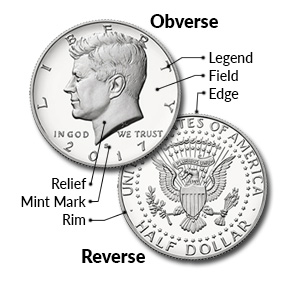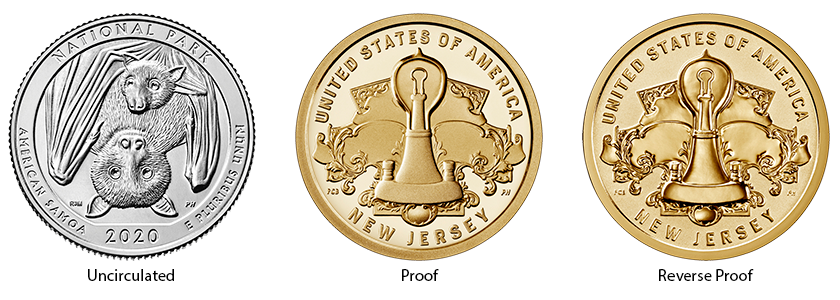What is the penny?
The penny is a part of the US currency and its value is 1 cent. It is important when paying in cash and allows us to pay the exact amount of money in cents for an item.
Coin Basics
The US mint produces all of the US's circulation coins as well as the collector coins. They have four facilities, which are located in Philadelphia, Denver, San Francisco, and West Point. Coins are made out of metals and have different parts, so let's go over them!
The obverse side of the coin is the side with a head on it. The reverse side is the side of the coin with no head on it. Coins also have different edges, or borders. As shown in the image below, the outer borders can be plain (no pattern), reeded, lettered, or decorated.
Coins' edges are also raised and help protect the coin from everyday wear. The raised part is called the rim of the coin. The legend of the coin is the lettering on the coin faces and the mint mark is a small symbol on a coin that shows where the coin was produced. The mint mark ensures that the coin has been produced correctly and can be used. The symbol can say P for Philadelphia, D for Denver, S for San Francisco, or W for West Point. The first branch of the US Mint was in Philadelphia, so in those times, the Mint Mark was not necessary. In 1835, however, the Congressional Act created Mint Marks and a few more Mint Branches. Unit 1968, mint marks were placed on the reverse side of coins. The relief part of the coin is raised slightly above the rest of the coin's surface and the field is the blank space part of the coin.
Coins also have different coin finishes.

Circulating coins are the coins that people use when buying ad selling items. The Mint produces these coins without extra steps used for the other types of coins. Uncirculating coins are coins the Mint produces for saving and collecting. They have quality enhancements and a brilliant finish. Proof coins are coins that have a mirror-like background. Enhanced finishes are coins with special finishes to bring out more detail in the coin.
How are coins produced?
First, the coin's design must be made. Once the design is drafted, the Secretary of Treasury approves it. Mint medallic artists then use the line drawing to create a 3D sculpt of the coin, which is then digitized and placed on a coin die, which is a stamp that is pressed into a metal.
1. Banking
The coin blanks are coins without any designs on them. They are simply flat metal discs. Blanks are made for Nickels, Dimes, Quarters, Half Dollars, and Dollars. The Mint buys blanks for pennies, numismatic coins, and bullion coins. To manufacture blanks, the Mint purchases coils of metal. The coil is then passed through a machine that punches the blanks at a rate of 14000 blanks per minute. The blanks are then taken to the annealing furnace. Scrap metal from the blanks being punches out is called webbing. The webbing is then shredded and recycled.
2. Annealing
The blanks are then annealed to preapre them for the striking. Annealing makes the mtal softer and allows the metal's shape to be modified without the metal breaking. The annealing furnace heats the balnks to 1600 degrees Fahrenheit and then quickly put into a tanks full of a combination of water, citric acid powder, annd lubricants. This ensures that the blanks don't stick together and is called slippery water. A machine lifts the blanks to drain and the blanks are taken to the washing area.
4. Upsetting
The edge of the coin is upset to create a raised rim. he upsetting mill places the blanks into a groove that is a little narrower than the diameter and the pushes the blank. This creates a slight rim. The planchets, as they are now called, are inspected to ensure the highest quality.
5. Striking
A striking machine press pushes both sides of the coin with a different die to make the patterns on the coin. Around 35 to 100 tons of pressure are applied on the coins. The circulating coin presses strike 750 coins per minute. Once the coins are finished being striked, the coins are dropped into trays. They are inspected and if the batch doesn't meet standard, the coins are sent to a waffler. The waffler bends all the coins into wavy lines and then sends the avy lines coins to be recycled.
6. Bagging and packaging
After the coins pass inspection, they are counted and weighed and then dumped into bulk storage banks that are sent arround the country.
Why is the US Mint stopping penny production?
The US Mint announced that they would end penny production on April 1, 2023, which would be the last batch of pennies. The last batch of pennies will be proof coins which will be auctioned off to coin collectors. The proceeds will be used to pay part of the national debt
So why are pennies not being produced anymore? Well, the high cost of manufactuing the pennies is a problem. Made out of copper, pennies cost just over 2 cents to produce, which is more than their spending value. Given that the Mint produces billions of pennies annually, taxpayers lost about $85.4 million from penny production alone. Stores will be unlikely to accept pennies after April 1, 2023 because of regulation imposed on them (they cannot give the pennies back as change and they have to pay an extra fee to process the pennies). Fortunately, the US Mint will create a penny buyback incentive in which the estimated 23 trillion unused pennies can be traded in for rewards. The pennies will then be melted and the cooper will be used for other purposes.
When paying in cash, stores will now round up prices to the nearest nickel, giving another reason for using cards or checks to pay.
But don't worry - the penny will never be forgotten!
